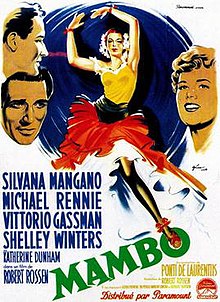fiction.wikisort.org - Movie
Mambo is an Italian/American international co-production film, produced by Dino De Laurentiis, Carlo Ponti and Paramount Pictures written and directed from 1952 to 1953 by Robert Rossen and released in 1955. A mambo craze spread through the USA in the 1950s, and Rossen aimed to repair his finances after almost two years without work since his 1951 House Un-American Activities Committee hearing.[1] The film co-stars Katherine Dunham who acted as the film's choreographer.
| Mambo | |
|---|---|
 | |
| Directed by | Robert Rossen |
| Written by |
|
| Produced by |
|
| Starring | |
| Cinematography | Harold Rosson |
| Edited by | Adriana Novelli |
| Music by | |
Production company | Ponti-De Laurentiis Cinematografica |
| Distributed by |
|
Release date |
|
Running time | 110 minutes |
| Countries |
|
| Language | English |
Plot
The film stars Silvana Mangano as Giovanna Masetti, a poor Venetian who is admired by the crafty croupier Mario Rossi (Vittorio Gassman) and the rich count Enrico Marisoni (Michael Rennie). Discovered by Toni Salerno (Shelley Winters), Giovanna lives out a dream to become a dancer and moves to Rome. She returns six months later to the competing affections of Mario and Enrico, resulting in a choice between the two and the dramatic finale.
Cast
- Silvana Mangano as Giovanna Masetti
- Michael Rennie as Enrico Marisoni
- Vittorio Gassman as Mario Rossi
- Shelley Winters as Toni Salerno
- Katherine Dunham as Dance teacher
- Mary Clare as Contessa Marisoni
- Eduardo Ciannelli as Padre di Giovanna
- Julie Robinson as Marisa
- Walter Zappolini
- Ottone Candiani
- Franco Caruso as Pio
- Mimi Dugini
- Giovanna Galletti
- Cecilia Maris as Barbara
- Martitia Palmer as Lena Masetti
- Sergio Parlato as Eduardo
Critical reception
Rossen later said, "Mambo was to be for fun only," but he "took it seriously, and it didn't come off."[1] The New York Times found the plot contorted, the script long and incredible, and lead actress Silvana Mangano's performance laborious, but praised Rossen's skilfully created moods, some decadent and others melancholy.[2] Alan Casty dismissed the film as a "mere job".[3]
However, in 2001 Dorothea Fischer-Hornung concluded that the film achieved more than Rossen and contemporary critics realised.[4] The lead, Italian shop-girl Giovanna, enrolls in a troupe led by real-time choreographer Katherine Dunham. The other three main characters in different ways try to dominate Giovanna, but she renounces one while the other two die violently. Giovanna returns to the troupe to devote herself to dance.[5] In the first scene a sexually charged dance accompanies a character's intense pass at Giovanna.[6] The rest of the first third of the film forms three stages of Giovanna's training: basic lessons in Durham's technique; Giovanna collapses; more advance training, using twirling and other movements to induce trances.[7][8] While most contemporary critics considered the cinematography of the dance scenes "confusing" and "handled with no real flair", one described it as "briefly, seems like genius", replacing conventional straight shots with sudden cuts, mirroring and montage.[9]
Notes
- Fischer-Hornung 2001, p. 94.
- Crowther 1955.
- Casty 1966.
- Fischer-Hornung 2001, p. 95.
- Fischer-Hornung 2001, p. 96-98.
- Fischer-Hornung 2001, p. 96.
- Fischer-Hornung 2001, p. 99.
- Fischer-Hornung 2001, p. 102.
- Fischer-Hornung 2001, p. 98-99.
References
- Casty, Alan (1966). "The Films of Robert Rossen". Film Quarterly. 20 (2): 3–12. doi:10.1525/fq.1966.20.2.04a00030. JSTOR 1210689.
- Crowther, Bosley (March 31, 1955). "'Mambo' Out of Step". The New York Times. Retrieved 27 February 2010.
- Fischer-Hornung, Dorothea (2001). "The Body Possessed: Katherine Dunham Dance Technique in Mambo". In Dorothea Fischer-Hornung, Alison D. Goeller (ed.). Embodying liberation: the Black body in American dance. Forum for European Contributions to African American Studies: FORECAAST. Vol. 4. Berlin-Hamburg-Münster: LIT Verlag. pp. 91–112. ISBN 3-8258-4473-0. Retrieved 25 Feb 2010.
See also
- List of American films of 1955
External links
- Mambo at IMDb
Другой контент может иметь иную лицензию. Перед использованием материалов сайта WikiSort.org внимательно изучите правила лицензирования конкретных элементов наполнения сайта.
WikiSort.org - проект по пересортировке и дополнению контента Википедии